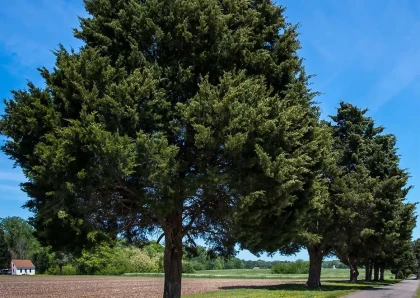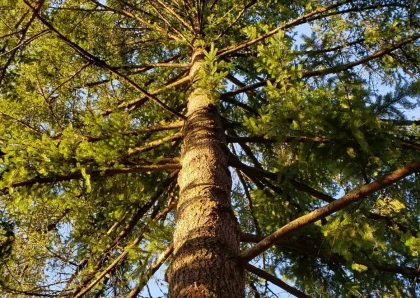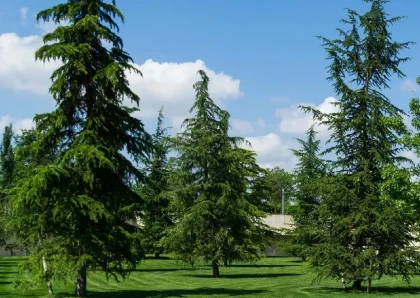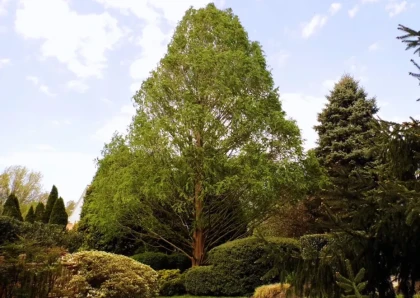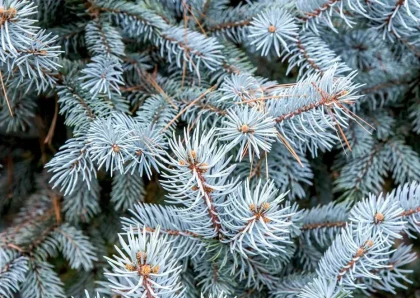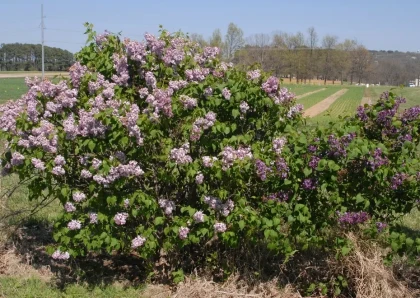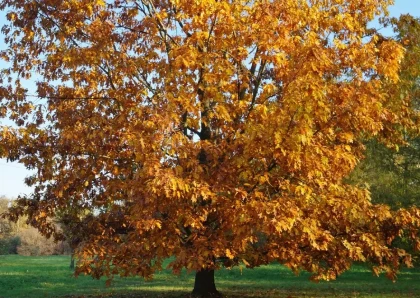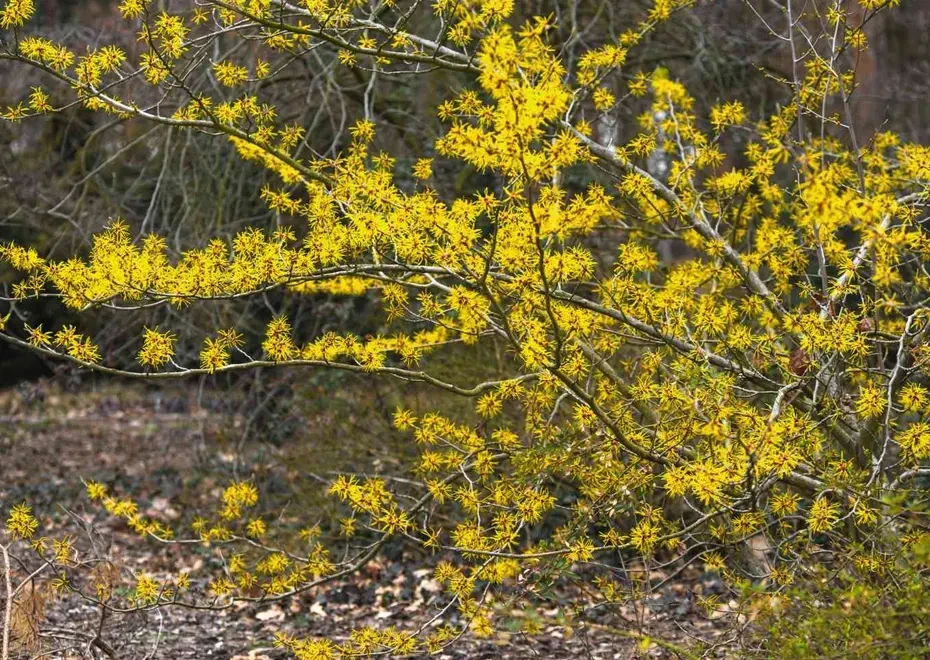
Witch Hazel Tree
Overview
The Witch Hazel tree (Hamamelis virginiana) is a deciduous shrub or small tree native to North America. It belongs to the Hamamelidaceae family and is known for its unique and attractive features. The name "Witch Hazel" is derived from the Old English word "wice," meaning "pliant" or "bendable," referring to the tree's flexible branches.
Appearance
The Witch Hazel tree typically grows to a height of 15 to 20 feet (4.5 to 6 meters) with a similar spread. It has smooth, grayish-brown bark and a rounded or vase-shaped crown. The leaves are alternate, oval-shaped, and have a wavy margin, turning vibrant yellow in the fall.
Flowers and Fruits
One of the most fascinating aspects of the Witch Hazel tree is its unique flowers. Unlike most trees that bloom in spring, the Witch Hazel produces its fragrant, spidery flowers in late fall to early winter, typically from October to December. These flowers have narrow, crinkled petals and are usually yellow, orange, or red in color, depending on the variety.
The fruits of the Witch Hazel tree are small, hard capsules that develop after pollination. They mature the following year and then explosively eject their seeds, shooting them several feet away from the tree.
Habitat and Distribution
Witch Hazel trees are commonly found in moist woodlands, along stream banks, and in ravines across eastern North America, from Canada to the United States. They prefer well-draining, acidic to neutral soils and can tolerate partial shade.
Traditional Uses
Native American tribes historically used various parts of the Witch Hazel tree for medicinal purposes. Extracts from its bark, leaves, and twigs were used for treating skin irritations, bruises, insect bites, and other ailments.
Modern Uses
Today, Witch Hazel extracts are still used in cosmetic and medicinal products, known for their astringent and anti-inflammatory properties. The extracts are commonly found in skincare products like toners and creams.
Types of Witch Hazel Tree
-
Hamamelis virginiana
Hamamelis virginiana, also known as Common Witch Hazel, is native to eastern North America. It is one of the most widely recognized and cultivated species of Witch Hazel. This species typically blooms in late fall with fragrant yellow flowers and has oval-shaped leaves that turn bright yellow in the autumn.
-
Hamamelis mollis
Hamamelis mollis, commonly called Chinese Witch Hazel or Yellow Witch Hazel, is native to China. It is known for its large, fragrant yellow flowers that appear in late winter or early spring, depending on the climate. The leaves of Hamamelis mollis are broad and have a slightly fuzzy texture.
-
Hamamelis vernalis
Hamamelis vernalis, also known as Ozark Witch Hazel or Vernal Witch Hazel, is native to the central United States. It typically blooms in late winter to early spring, producing fragrant, reddish-purple or copper-colored flowers. The leaves of Hamamelis vernalis are smaller and more rounded compared to other species.
-
Hamamelis japonica
Hamamelis japonica, known as Japanese Witch Hazel, is native to Japan. It blooms in late winter to early spring, showcasing fragrant yellow flowers. The leaves are glossy and have a more elongated shape compared to other Witch Hazel species.
-
Hamamelis x intermedia
Hamamelis x intermedia, commonly referred to as Hybrid Witch Hazel, is a group of hybrid Witch Hazel trees resulting from crossing different species. These hybrids often exhibit a wide range of flower colors, including red, orange, and yellow, and they bloom in late winter to early spring.
Different types of wood products that can be made from Witch Hazel Tree
While Witch Hazel (Hamamelis) trees are not commonly used for large-scale wood production, some hypothetical wood products could include:
- Small Craft Items: Witch Hazel wood could be used for crafting small items like wooden spoons, spatulas, and other kitchen utensils.
- Carvings and Artwork: The fine-grained nature of Witch Hazel wood makes it suitable for intricate carvings and small sculptures.
- Walking Sticks: The flexibility and strength of Witch Hazel wood could be ideal for crafting walking sticks.
- Wooden Jewelry: Witch Hazel wood could be used to create unique and lightweight wooden jewelry pieces.
- Wooden Toys: Witch Hazel wood might be suitable for crafting small wooden toys and decorative figurines.
Please note that the use of Witch Hazel wood for commercial purposes may not be practical due to its limited availability and size. Additionally, Witch Hazel trees are often protected or grown for ornamental and medicinal purposes, rather than timber production.
Benefits of Witch Hazel Tree
-
Medicinal Uses
Witch Hazel has a long history of medicinal use. Extracts from its leaves, bark, and twigs contain tannins and other compounds that possess astringent, anti-inflammatory, and antioxidant properties. These extracts are commonly used in skincare products, such as toners and ointments, to soothe and reduce skin irritation, insect bites, and minor wounds.
-
Ornamental Value
The Witch Hazel tree is valued for its ornamental appeal, especially in late winter and early spring when it produces unique and fragrant flowers. The spidery flowers can be yellow, orange, or red, depending on the species or variety. Witch Hazel's vibrant fall foliage adds further aesthetic value to landscapes and gardens.
-
Wildlife Benefits
Witch Hazel provides valuable resources for wildlife. The late-season blooming of its flowers serves as a critical nectar source for bees, butterflies, and other pollinators when few other plants are in bloom. The small fruits that develop after pollination are also consumed by birds and small mammals.
-
Erosion Control
Witch Hazel's extensive root system helps stabilize soil, making it beneficial for controlling erosion on slopes and along stream banks. Its ability to thrive in moist woodland environments makes it well-suited for such ecological roles.
-
Native Ecosystem Support
Witch Hazel is a native plant species in North America, and its presence contributes to the ecological balance of natural ecosystems. It provides habitat and food sources for various wildlife species and plays a role in supporting biodiversity.
Cons of Witch Hazel Tree
-
Slow Growth Rate
Witch Hazel trees have a slow growth rate, which can be a disadvantage if rapid growth and development are desired for landscaping or timber production purposes.
-
Small Size
The small size of Witch Hazel trees limits their use in certain commercial applications, as they do not yield large volumes of timber or significant wood products.
-
Susceptibility to Some Pests and Diseases
While Witch Hazel is generally healthy, it may be susceptible to certain pests and diseases that can affect its growth and appearance. Monitoring and appropriate pest management strategies may be required in some cases.
-
Not Suitable for Large-Scale Timber Production
Due to its small size and slow growth, Witch Hazel is not considered a major species for commercial timber production. It is not commonly used for large-scale woodworking projects.
-
Specific Growing Conditions
Witch Hazel trees prefer specific growing conditions, including moist, acidic to neutral soils. They may not thrive in dry or alkaline soils, limiting their adaptability to various environments.
Planting Tips for Witch Hazel Tree
-
Choose the Right Location
Select a planting site that receives partial to full sun. Witch Hazel trees prefer well-draining, moist, and slightly acidic to neutral soil. Avoid areas prone to waterlogging or standing water.
-
Planting Time
The best time to plant a Witch Hazel tree is in the fall, typically from late September to early November, or in early spring before new growth emerges. Planting during these seasons allows the tree to establish its root system before facing extreme weather conditions.
-
Planting Depth
Dig a hole that is as deep as the root ball and at least twice as wide. Loosen the soil in the planting area to encourage root penetration and proper drainage.
-
Watering
Water the Witch Hazel tree regularly during the first year after planting to ensure proper establishment. Afterward, the tree generally tolerates dry periods, but occasional watering during prolonged droughts can be beneficial, especially for young trees.
-
Mulching
Apply a layer of organic mulch around the base of the tree to conserve soil moisture, regulate soil temperature, and suppress weed growth. Leave a gap between the mulch and the tree trunk to prevent moisture buildup and potential rot.
Maintenance Tips
-
Pruning
Pruning is generally not required for Witch Hazel trees, but you can remove dead, damaged, or diseased branches as needed. If shaping is desired, prune immediately after flowering in early spring.
-
Fertilizing
Witch Hazel trees usually do not require regular fertilization. However, if the tree shows signs of nutrient deficiencies, you can apply a balanced fertilizer in early spring. Avoid excessive use of nitrogen-rich fertilizers, as it can promote weak growth.
-
Pest and Disease Monitoring
Regularly inspect the Witch Hazel tree for signs of pests or diseases. If any issues are detected, promptly address them using appropriate integrated pest management strategies or consult with a professional arborist for guidance.
-
Protection from Winter Winds
Young Witch Hazel trees can be susceptible to winter desiccation and damage from strong winds. Consider using burlap or other windbreak materials to protect the tree during the winter months.
-
Rejuvenation Pruning
If your Witch Hazel tree becomes overgrown or starts to decline, it can benefit from rejuvenation pruning. This involves cutting the tree back to a few inches above the ground in late winter or early spring to stimulate new growth and rejuvenate the plant.
Conclusion
The Witch Hazel tree (Hamamelis) is a unique and valuable plant known for its medicinal uses, ornamental appeal, and ecological contributions. Native to North America and parts of Asia, this deciduous shrub or small tree offers numerous benefits that make it a worthwhile addition to landscapes and gardens.
With its extract used in skincare products for its astringent and anti-inflammatory properties, Witch Hazel has been treasured for its medicinal uses for centuries. Its fragrant and colorful late-season flowers add beauty and charm to gardens, making it a popular choice among landscape enthusiasts.
Beyond its aesthetic and medicinal qualities, Witch Hazel plays a vital role in supporting wildlife. Its late blooming flowers provide nectar for bees, butterflies, and other pollinators when other plants are scarce. The small fruits that follow are a source of food for birds and small mammals.
While Witch Hazel may have some limitations, such as its slow growth rate and specific growing requirements, proper planting and care can ensure its successful establishment and healthy growth. Regular monitoring for pests and diseases, appropriate pruning, and protection from harsh conditions can help maintain the tree's health and longevity.
Overall, the Witch Hazel tree is a versatile and valuable plant that continues to captivate with its unique characteristics, making it a cherished component of natural and cultivated landscapes alike.
Frequently Asked Questions (FAQs)
-
1. What is a Witch Hazel tree?
The Witch Hazel tree (Hamamelis) is a deciduous shrub or small tree known for its medicinal properties, ornamental flowers, and ecological benefits. It belongs to the Hamamelidaceae family and is native to North America and parts of Asia.
-
2. When does the Witch Hazel tree bloom?
Witch Hazel trees typically bloom in late fall to early spring, depending on the species or variety. The unique and fragrant flowers, resembling spidery clusters, can be yellow, orange, or red in color.
-
3. What are the medicinal uses of Witch Hazel?
Witch Hazel extracts from its leaves, bark, and twigs have astringent and anti-inflammatory properties. These extracts are commonly used in skincare products to soothe and reduce skin irritation, insect bites, and minor wounds.
-
4. How tall does a Witch Hazel tree grow?
Witch Hazel trees typically grow to a height of 15 to 20 feet (4.5 to 6 meters) with a similar spread. They have a rounded or vase-shaped crown and are considered small to medium-sized trees.
-
5. Can I plant a Witch Hazel tree in my garden?
Yes, you can plant a Witch Hazel tree in your garden if you have the appropriate growing conditions. Witch Hazel trees prefer partial to full sun, well-draining soil, and slightly acidic to neutral pH. They are well-suited for moist woodland environments and can be a beautiful addition to landscapes and gardens.
-
6. Are Witch Hazel trees drought-tolerant?
Once established, Witch Hazel trees are relatively drought-tolerant. However, regular watering during the first year after planting is essential for proper establishment. During prolonged dry periods, occasional watering may be beneficial, especially for young trees.
-
7. Do Witch Hazel trees attract wildlife?
Yes, Witch Hazel trees attract wildlife. The late-season blooming flowers provide a critical nectar source for bees, butterflies, and other pollinators. Additionally, the small fruits that follow the flowers are consumed by birds and small mammals, contributing to the tree's ecological role in supporting biodiversity.




